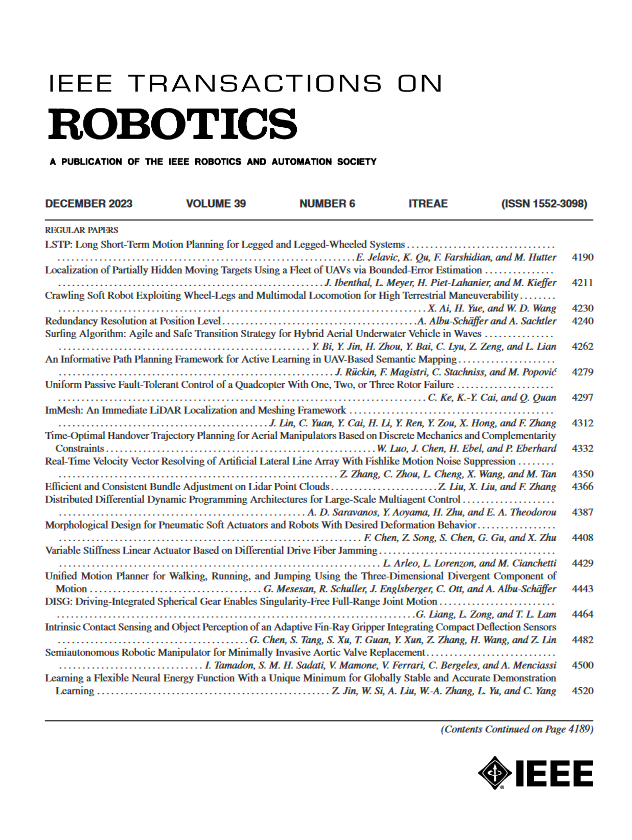Generalizable Motion Policies Through Keypoint Parameterization and Transportation Maps
IF 10.5
1区 计算机科学
Q1 ROBOTICS
引用次数: 0
Abstract
Learning from Interactive Demonstrations has revolutionized the way nonexpert humans teach robots. It is enough to kinesthetically move the robot around to teach pick-and-place, dressing, or cleaning policies. However, the main challenge is correctly generalizing to novel situations, e.g., different surfaces to clean or different arm postures to dress. This article proposes a novel task parameterization and generalization to transport the original robot policy, i.e., position, velocity, orientation, and stiffness. Unlike the state of the art, only a set of keypoints is tracked during the demonstration and the execution, e.g., a point cloud of the surface to clean. We then propose to fit a nonlinear transformation that would deform the space and then the original policy using the paired source and target point sets. The use of function approximators like Gaussian Processes allows us to generalize, or transport, the policy from every space location while estimating the uncertainty of the resulting policy due to the limited task keypoints and the reduced number of demonstrations. We compare the algorithm’s performance with state-of-the-art task parameterization alternatives and analyze the effect of different function approximators. We also validated the algorithm on robot manipulation tasks, i.e., different posture arm dressing, different location product reshelving, and different shape surface cleaning.基于关键点参数化和运输映射的可推广运动策略
从交互式演示中学习已经彻底改变了非专业人员教机器人的方式。从动作上移动机器人来教授拾取、穿衣或清洁政策就足够了。然而,主要的挑战是正确地归纳到新的情况,例如,不同的表面清洁或不同的手臂姿势穿衣服。本文提出了一种新的任务参数化和泛化方法来传递机器人原有的策略,即位置、速度、方向和刚度。与目前的技术状态不同,在演示和执行期间,只有一组关键点被跟踪,例如,要清洁的表面的点云。然后,我们提出拟合一个非线性变换,使空间变形,然后使用配对的源点集和目标点集来拟合原始策略。像高斯过程这样的函数逼近器的使用允许我们从每个空间位置泛化或传输策略,同时估计由于有限的任务关键点和减少的演示次数而产生的策略的不确定性。我们比较了该算法与最先进的任务参数化方案的性能,并分析了不同函数逼近器的效果。我们还在机器人操作任务上验证了算法的有效性,即不同姿势的手臂包扎、不同位置的产品重新上架以及不同形状的表面清洁。
本文章由计算机程序翻译,如有差异,请以英文原文为准。
求助全文
约1分钟内获得全文
求助全文
来源期刊

IEEE Transactions on Robotics
工程技术-机器人学
CiteScore
14.90
自引率
5.10%
发文量
259
审稿时长
6.0 months
期刊介绍:
The IEEE Transactions on Robotics (T-RO) is dedicated to publishing fundamental papers covering all facets of robotics, drawing on interdisciplinary approaches from computer science, control systems, electrical engineering, mathematics, mechanical engineering, and beyond. From industrial applications to service and personal assistants, surgical operations to space, underwater, and remote exploration, robots and intelligent machines play pivotal roles across various domains, including entertainment, safety, search and rescue, military applications, agriculture, and intelligent vehicles.
Special emphasis is placed on intelligent machines and systems designed for unstructured environments, where a significant portion of the environment remains unknown and beyond direct sensing or control.
 求助内容:
求助内容: 应助结果提醒方式:
应助结果提醒方式:


